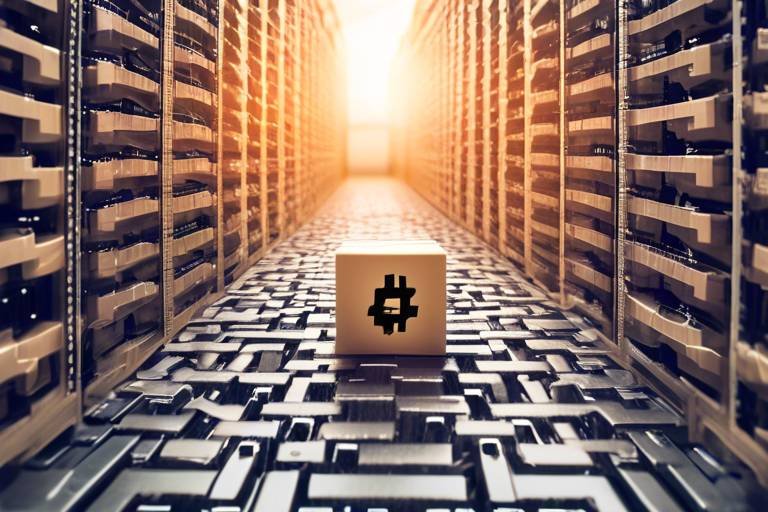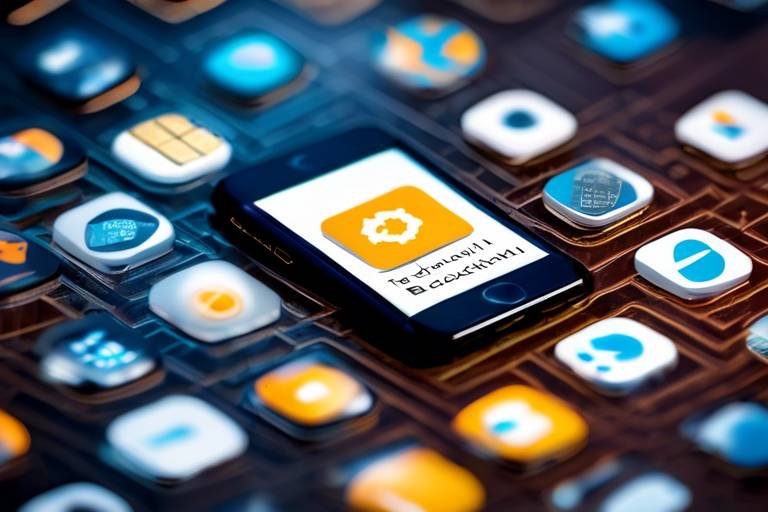How Blockchain Can Enhance Data Sharing Among Government Agencies
In an era where data is often described as the new oil, the need for efficient and secure data sharing among government agencies has never been more critical. Imagine a world where every piece of information is not only accessible but also secure and trustworthy. This is where blockchain technology steps in, promising to revolutionize how government entities interact with data. By leveraging the principles of decentralization, transparency, and immutability, blockchain can significantly enhance the way public administration handles data sharing.
Currently, government agencies face numerous challenges when it comes to sharing information. Traditional systems often lead to silos, where data is trapped within individual departments, making collaboration cumbersome and inefficient. Furthermore, concerns around data security and privacy create barriers that hinder the flow of information, which is essential for effective governance. With blockchain, these challenges can be addressed head-on, paving the way for a more integrated and responsive public sector.
One of the most compelling aspects of blockchain is its ability to create a decentralized ledger that ensures data integrity. This means that once data is recorded on the blockchain, it cannot be altered or deleted without consensus from the network. This feature alone enhances trust among agencies, as they can be confident that the information they are sharing is accurate and tamper-proof. Imagine the implications of such a system: agencies can share sensitive data without the fear of it being compromised, leading to more effective decision-making and improved public services.
Moreover, blockchain's inherent design fosters transparency and accountability. Each transaction on the blockchain is recorded with a timestamp, creating an immutable audit trail that can be accessed by authorized personnel. This not only promotes accountability but also builds public trust, as citizens can see that their government is operating with integrity. The ability to track data lineage and access history can significantly reduce instances of fraud and misuse of information.
As we delve deeper into the potential of blockchain for enhancing data sharing among government agencies, it becomes evident that the technology is not just a trend but a fundamental shift in how we think about data governance. The future of public administration could very well be shaped by the principles of blockchain, leading to a more transparent, efficient, and secure data-sharing ecosystem.
- What is blockchain technology?
Blockchain technology is a decentralized digital ledger that records transactions across many computers so that the record cannot be altered retroactively, ensuring data integrity and security.
- How does blockchain improve data sharing?
Blockchain enhances data sharing by providing a secure, transparent, and immutable platform for data exchange, reducing risks associated with data breaches and unauthorized access.
- What are the benefits of using blockchain in government?
The benefits include improved data security, enhanced transparency, accountability through audit trails, and increased efficiency in collaboration among agencies.
- Are there any real-world examples of blockchain implementation?
Yes, several government agencies around the world have successfully implemented blockchain solutions for various applications, including land registries, identity verification, and supply chain management.

Understanding Blockchain Technology
Blockchain technology is often described as a revolutionary force that has the potential to reshape various industries, including government operations. At its core, blockchain is a decentralized ledger that records transactions across multiple computers, ensuring that the data is secure, transparent, and tamper-proof. Imagine a digital notebook where every page is locked, and once something is written, it cannot be erased. This is the essence of blockchain—once data is added to the chain, it remains there permanently, creating an unalterable history.
The foundational principles of blockchain technology revolve around three key elements: decentralization, security, and transparency. Decentralization means that no single entity has control over the entire network; instead, each participant has access to the same information, which reduces the risk of corruption or fraud. Security is achieved through cryptographic techniques that protect data from unauthorized access and ensure that only verified users can make changes. Transparency allows all participants to view the same data, fostering trust and accountability among stakeholders.
To further illustrate how blockchain operates, let’s break down its structure:
| Component | Description |
|---|---|
| Blocks | Data containers that hold transaction records, timestamp, and a unique identifier. |
| Chain | A sequence of blocks that are linked together, forming a continuous record. |
| Nodes | Computers that participate in the blockchain network, maintaining copies of the entire ledger. |
| Consensus Mechanism | Protocols that ensure all nodes agree on the validity of transactions before they are added to the blockchain. |
In the context of government data sharing, blockchain can serve as a powerful tool to enhance collaboration among various agencies. For instance, when different departments need to share sensitive information, they can utilize blockchain to create a secure and transparent environment where data can be exchanged without fear of breaches or unauthorized access. This not only streamlines processes but also builds public trust in government operations.
As we continue to explore the transformative potential of blockchain, we must recognize its ability to create a more efficient and secure framework for data sharing among government agencies. The future of public administration could very well be defined by how effectively these entities adopt and integrate blockchain technology into their operations.

Current Challenges in Data Sharing
In today's interconnected world, the ability for government agencies to share data efficiently is more crucial than ever. However, they face a myriad of challenges that can make this task seem daunting. One of the primary obstacles is the issue of data security. With increasing cyber threats, government entities are understandably cautious about sharing sensitive information. Data breaches can lead to severe repercussions, not just for the agencies involved but also for the citizens whose information is compromised. The fear of unauthorized access can create a culture of hesitation and reticence among agencies, stifling collaboration that could otherwise enhance public services.
Another significant hurdle is the privacy concerns that arise when sharing data. Government agencies are tasked with protecting personal information, and any perceived risk to privacy can halt data-sharing initiatives in their tracks. This is particularly relevant in areas like healthcare and social services, where sensitive data is abundant. Citizens expect their information to be safeguarded, and agencies must navigate the fine line between transparency and privacy. In fact, many agencies struggle with the legal and ethical implications of sharing data, often leading to inconsistent practices across jurisdictions.
Moreover, there are inefficiencies in the current data-sharing processes that hinder effective collaboration. Many agencies operate in silos, using outdated systems that are not designed for interoperability. This lack of integration can lead to duplication of efforts and wasted resources. For instance, if two departments are collecting similar data but using different platforms, it can create confusion and lead to discrepancies. The time and effort spent reconciling these differences could be better utilized in delivering services to the public. The situation is akin to trying to fit puzzle pieces from different sets together; they simply don’t align.
To illustrate the scale of these challenges, consider the following table that highlights the key obstacles faced by government agencies in data sharing:
| Challenge | Description |
|---|---|
| Data Security | Concerns about breaches and unauthorized access to sensitive information. |
| Privacy Concerns | Legal and ethical implications of sharing personal data. |
| Inefficiencies | Outdated systems that hinder interoperability and collaboration. |
In addition to these challenges, there is also the matter of cultural resistance within government agencies. Change can be met with skepticism, especially when it involves adopting new technologies. Employees may be accustomed to traditional methods, and the thought of transitioning to a blockchain-based system can feel overwhelming. This resistance can stall progress and prevent agencies from realizing the full potential of data sharing.
Ultimately, these challenges create a complex landscape for government agencies striving to enhance their data-sharing capabilities. However, recognizing these obstacles is the first step toward finding effective solutions. As we explore the transformative potential of blockchain technology, it becomes clear that it holds the key to overcoming many of these barriers, paving the way for a more efficient and secure data-sharing environment.

Data Security Concerns
In today's digital era, data security is not just a concern; it's a critical priority for government agencies. As they strive to share information efficiently, they often find themselves grappling with the risks associated with data breaches and unauthorized access. Imagine a scenario where sensitive citizen data, such as social security numbers or health records, is compromised due to inadequate security measures. The ramifications could be catastrophic, not just for the individuals affected, but also for public trust in government systems.
One of the most pressing issues in data sharing is the vulnerability of centralized databases. Traditional systems, where data is stored in a single location, are like a magnet for cyberattacks. Hackers only need to breach one point to access a treasure trove of sensitive information. In contrast, blockchain technology operates on a decentralized model, distributing data across a network of computers. This means that even if one node is compromised, the integrity of the entire system remains intact. By leveraging blockchain, government agencies can significantly reduce the risks associated with data sharing.
Moreover, the design of blockchain inherently enhances security through its use of cryptographic techniques. Each transaction is encrypted and linked to the previous one, creating a chain that is virtually impossible to alter without detection. This not only protects data from unauthorized access but also ensures that any changes made are traceable. Imagine a digital ledger where every transaction is recorded in an unchangeable format; this is the power of blockchain.
To further bolster security, blockchain employs access control mechanisms that allow only authorized personnel to view or manipulate sensitive data. This is akin to having a high-tech vault with multiple layers of security. Agencies can set permissions based on roles, ensuring that individuals only access the information necessary for their duties. This minimizes the risk of insider threats, which are often overlooked in traditional data sharing practices.
In addition to access control, blockchain creates immutable audit trails. Each interaction with the data is recorded in a way that cannot be altered or deleted, fostering a culture of accountability. This transparency is crucial for government agencies, as it builds public trust and ensures that data sharing practices are conducted ethically. Citizens can feel confident knowing that their information is handled with the utmost care and integrity.
In conclusion, while data security concerns are a significant hurdle for government agencies, the adoption of blockchain technology presents a viable solution. By decentralizing data storage, utilizing cryptographic techniques, and implementing robust access controls, blockchain not only enhances security but also promotes transparency and accountability. As we continue to navigate the complexities of data sharing, embracing such innovative solutions will be essential in safeguarding sensitive information and maintaining public trust.
- What is blockchain technology? Blockchain is a decentralized digital ledger that securely records transactions across multiple computers, ensuring data integrity and security.
- How does blockchain enhance data security? By decentralizing data storage, encrypting transactions, and creating immutable audit trails, blockchain significantly reduces the risks of data breaches and unauthorized access.
- What are the benefits of using blockchain for government data sharing? The benefits include improved security, enhanced transparency, streamlined processes, and increased public trust.

Encryption and Access Control
When it comes to sharing sensitive data among government agencies, the stakes couldn't be higher. Imagine a world where confidential information is easily accessible to unauthorized individuals—it's a nightmare scenario that keeps many administrators awake at night. This is where encryption and access control come into play, acting as the guardians of data integrity and security within blockchain technology.
Encryption is the process of converting data into a coded format that can only be accessed by those who possess the correct decryption key. Think of it as a secret language; even if someone intercepts the data, they won't understand it without the key. In the realm of blockchain, encryption ensures that only authorized users can view or manipulate sensitive information, effectively keeping prying eyes at bay. This is particularly crucial for government agencies that handle personal data, financial records, and classified information.
Access control, on the other hand, determines who can view or use the data. By implementing strict access controls, agencies can ensure that only specific individuals or groups can access certain types of information. This is akin to having a secure vault where only a select few possess the key. In a blockchain context, access control can be managed through various methods, such as role-based access or attribute-based access, which define permissions based on user roles or attributes.
To illustrate how these two components work together, consider the following table:
| Component | Description | Benefits |
|---|---|---|
| Encryption | Transforms data into a secure format | Protects data from unauthorized access and breaches |
| Access Control | Regulates who can access specific data | Ensures that only authorized personnel can view sensitive information |
By combining encryption and access control, blockchain technology not only enhances the security of data sharing among government agencies but also fosters a culture of accountability. When agencies can confidently share information without fear of breaches, they can collaborate more effectively, leading to improved public services and outcomes.
Moreover, the use of blockchain's inherent features allows for the creation of smart contracts—self-executing contracts with the terms of the agreement directly written into code. These smart contracts can automate access control processes, ensuring that permissions are granted or revoked based on predefined criteria. This automation reduces human error and increases efficiency, making the entire data sharing process smoother and more reliable.
In conclusion, the integration of encryption and access control within blockchain technology is not just a technical enhancement; it's a fundamental shift in how government agencies can safeguard their data. As we look to the future, the potential for these technologies to revolutionize data sharing practices is immense, paving the way for a more secure, transparent, and efficient public administration.
- What is encryption in blockchain? Encryption in blockchain refers to the process of converting data into a secure format that can only be accessed by authorized users.
- How does access control work in blockchain? Access control in blockchain regulates who can view or use specific data, ensuring that only authorized personnel have access to sensitive information.
- Why are encryption and access control important for government agencies? They are crucial for protecting sensitive data from unauthorized access and breaches, thereby enhancing trust and collaboration among agencies.

Audit Trails and Accountability
In the realm of government data sharing, the concepts of audit trails and accountability are paramount. Imagine a world where every transaction, every piece of data shared, is recorded in a way that cannot be altered or erased. This is precisely what blockchain technology offers. By creating an immutable record of all activities, blockchain ensures that every interaction among government agencies is transparent and traceable. This level of transparency not only enhances trust among agencies but also builds public confidence in government operations.
When we talk about audit trails in blockchain, we're referring to a comprehensive log of all transactions that have occurred on the network. Each transaction is time-stamped and linked to the previous one, forming a chain of events that can be reviewed at any time. This means that if a data breach occurs or if there's a dispute regarding data integrity, agencies can easily trace back through the audit trail to identify where things went wrong. This is akin to having a detailed map of every step taken in a journey, making it easy to pinpoint any detours or missteps along the way.
Furthermore, accountability in data sharing is significantly enhanced through the use of blockchain. With traditional data-sharing methods, it can be challenging to determine who accessed what information and when. However, with blockchain, every access attempt is logged, ensuring that only authorized personnel can view sensitive data. This creates a culture of responsibility where individuals know that their actions are being monitored and recorded. In this context, accountability isn't just a buzzword; it's a fundamental principle that fosters a sense of duty among government employees.
To illustrate the benefits of audit trails and accountability in blockchain, consider the following table:
| Feature | Traditional Systems | Blockchain Systems |
|---|---|---|
| Data Integrity | Prone to tampering | Immutable records |
| Transparency | Limited visibility | Full visibility |
| Accountability | Difficult to track | Easy to trace actions |
| Access Control | Vulnerable to breaches | Secure and controlled |
Ultimately, the integration of blockchain technology into government data-sharing practices revolutionizes how accountability and audit trails are managed. By ensuring that every action is recorded and accessible, agencies can not only protect sensitive information but also foster a culture of transparency and trust. This is crucial in an era where public scrutiny is at an all-time high, and citizens demand to know how their data is being handled. Blockchain empowers government entities to meet these expectations, paving the way for a more secure and trustworthy public administration.
- What is blockchain technology? Blockchain is a decentralized digital ledger that records transactions across many computers, ensuring that the recorded transactions cannot be altered retroactively.
- How does blockchain enhance data security? By using cryptographic techniques and creating immutable records, blockchain significantly reduces the risks of data breaches and unauthorized access.
- What are audit trails in blockchain? Audit trails in blockchain refer to the comprehensive logs of all transactions that are time-stamped and linked, allowing for easy tracking and accountability.
- Can blockchain improve transparency in government? Yes, blockchain provides full visibility into data transactions, fostering a transparent environment where actions can be traced back easily.

Interoperability Among Agencies
Interoperability among government agencies is not just a buzzword; it’s a critical component in the quest for efficient and effective public service. Imagine a world where different departments can seamlessly share information, akin to how friends share photos on social media without any hiccups. In today’s complex governmental landscape, however, this is often easier said than done. Various agencies utilize different systems, databases, and protocols, leading to silos that hinder collaboration and slow down decision-making processes. This is where blockchain technology steps in as a game-changer.
Blockchain provides a solution to these interoperability challenges by creating a standardized platform that allows various government entities to communicate and share data securely and efficiently. By employing a decentralized ledger, blockchain ensures that all parties have access to the same information in real-time, reducing discrepancies and fostering trust. Think of it as a universal translator for government data—no more misunderstandings or miscommunications, just clear, concise, and accurate information flowing freely between agencies.
Furthermore, blockchain’s ability to maintain a single source of truth is invaluable. When data is recorded on a blockchain, it becomes immutable, meaning it cannot be altered or deleted without consensus from all parties involved. This feature not only enhances transparency but also ensures that all agencies are working from the same data set, which is crucial for effective collaboration. For instance, if an agency updates a public health record, that change is instantly reflected across all connected agencies, ensuring that everyone is on the same page.
To illustrate the potential of blockchain in enhancing interoperability, consider the following table that outlines the key benefits:
| Benefit | Description |
|---|---|
| Real-time Data Sharing | Agencies can access updated information instantly, leading to timely decisions and actions. |
| Enhanced Security | Data integrity is ensured through cryptographic techniques, reducing the risk of unauthorized access. |
| Increased Trust | Immutable records build confidence among agencies and the public, fostering cooperation. |
| Cost Efficiency | Reduced redundancy and improved processes can lead to significant cost savings for government operations. |
In addition to these benefits, blockchain can support the development of standardized protocols for data exchange. By establishing common frameworks, agencies can easily integrate their systems, much like how different apps can communicate on your smartphone. This not only simplifies the sharing process but also encourages innovation as agencies can build new applications on top of existing blockchain infrastructure.
Ultimately, the interoperability facilitated by blockchain technology can transform the way government agencies operate, leading to a more connected and responsive public administration. As we move forward, embracing this technology will be crucial in overcoming the barriers that have long hindered efficient data sharing.

Case Studies of Blockchain Implementation
As the world becomes increasingly digital, government agencies are seeking innovative solutions to enhance their data sharing capabilities. Blockchain technology has emerged as a promising tool, and several agencies have already taken the plunge. Let’s explore some fascinating case studies that illustrate the successful implementation of blockchain in government data sharing.
One standout example comes from the Estonian government, which has been a pioneer in digital governance. Estonia has integrated blockchain technology into its e-Residency program, allowing digital entrepreneurs from around the world to establish businesses online. By utilizing a decentralized ledger, Estonia ensures that all transactions are secure and transparent. This implementation not only enhances data security but also simplifies the process of business registration, making it easier for foreign entrepreneurs to access Estonian markets.
Another compelling case is the United States Department of Veterans Affairs (VA), which has experimented with blockchain to improve the management of veteran records. The VA faced significant challenges in sharing data securely among various departments. By adopting blockchain, they created a secure platform that allows for real-time updates and sharing of veteran information. This initiative not only enhances data accuracy but also reduces the time veterans spend waiting for services, ultimately improving their overall experience.
In addition to these examples, the Singapore government has launched a pilot project using blockchain for land registration. This initiative aims to streamline the land transfer process, which has historically been fraught with inefficiencies. By implementing a blockchain-based system, Singapore can ensure that land ownership records are immutable and easily accessible to relevant parties. This has the potential to significantly reduce fraud and disputes over land ownership, fostering a more trustworthy environment for real estate transactions.
These case studies demonstrate that blockchain is not just a buzzword; it is a practical solution that addresses real-world challenges in government data sharing. However, the successful implementation of blockchain technology requires careful planning and collaboration among various stakeholders. A key takeaway from these initiatives is the importance of engaging with technology experts and ensuring that all parties involved understand the benefits and limitations of blockchain.
As more government agencies explore blockchain, it’s essential to learn from these early adopters. The lessons learned from these case studies can guide future implementations, helping to avoid common pitfalls and maximize the benefits of this transformative technology.
- What is blockchain technology?
Blockchain is a decentralized digital ledger that records transactions across multiple computers in a way that ensures the security and integrity of the data. - How does blockchain enhance data sharing among government agencies?
Blockchain enhances data sharing by providing a secure, transparent, and immutable record of transactions, reducing the risk of data breaches and unauthorized access. - What are some real-world examples of blockchain in government?
Examples include Estonia’s e-Residency program, the U.S. Department of Veterans Affairs' management of veteran records, and Singapore’s land registration project. - What are the challenges of implementing blockchain in government?
Challenges include the need for technical expertise, ensuring interoperability among different systems, and addressing privacy concerns.

Successful Pilot Projects
In the realm of government operations, the implementation of blockchain technology has led to some remarkable pilot projects that showcase its potential to revolutionize data sharing. One standout example is the initiative by the Estonian government, which has been a pioneer in adopting blockchain for public services. Estonia's e-Residency program utilizes blockchain to provide secure digital identities, allowing citizens and businesses to access services without the fear of data breaches. This program not only enhances security but also streamlines processes, making it easier for users to interact with government services.
Another significant pilot project is the U.S. Department of Homeland Security's use of blockchain for sharing information related to immigration and border security. This initiative aims to create a secure and immutable record of data that can be shared among various agencies without compromising sensitive information. By using blockchain, the department can ensure that only authorized personnel access the data, thus mitigating risks associated with data sharing.
Moreover, in the healthcare sector, the National Health Service (NHS) in the UK has explored blockchain for storing and sharing patient records. This project aims to enhance patient privacy while improving the efficiency of information exchange between healthcare providers. With blockchain, patient data can be encrypted and shared securely, ensuring that only those with the right permissions can access it. This not only protects sensitive information but also fosters trust among patients regarding how their data is handled.
These pilot projects demonstrate the transformative capabilities of blockchain technology in enhancing data sharing among government agencies. The key outcomes of these initiatives include:
- Increased Security: By leveraging blockchain’s decentralized nature, agencies can significantly reduce the risk of data breaches.
- Improved Efficiency: Streamlined processes lead to faster data sharing and reduced bureaucratic delays.
- Enhanced Transparency: Immutable records promote accountability and trust in government operations.
As these projects continue to evolve, they provide valuable lessons for other government entities looking to harness blockchain technology. The success of these initiatives not only showcases the practical applications of blockchain but also sets a precedent for future projects aimed at improving public administration. The potential for broader application across various sectors is immense, and as more agencies recognize the benefits, we can expect a significant shift in how government data is shared and managed.
- What is blockchain technology?
Blockchain is a decentralized digital ledger that records transactions across many computers securely and transparently, ensuring that the data cannot be altered retroactively. - How does blockchain enhance data security?
Blockchain enhances data security through encryption and decentralized storage, making it difficult for unauthorized users to access or alter data. - Can blockchain be used in all government sectors?
Yes, blockchain has applications in various sectors, including healthcare, finance, and public safety, improving efficiency and security in data sharing. - What are the challenges of implementing blockchain in government?
Challenges include the need for standardization, integration with existing systems, and addressing regulatory concerns.

Long-term Implications and Future Trends
As we look ahead, the long-term implications of blockchain technology in government data sharing are nothing short of revolutionary. Imagine a world where data flows seamlessly between agencies, where every transaction is recorded with unbreakable security, and where citizens have complete trust in their government’s handling of sensitive information. This is not just a dream; it is becoming a reality as blockchain technology matures and evolves.
One of the most significant trends we can expect is the increased adoption of decentralized systems. Unlike traditional databases that are centralized and vulnerable to attacks, blockchain's decentralized nature means that data is stored across numerous nodes, making it incredibly difficult for hackers to compromise an entire system. This shift will likely lead to enhanced security and resilience against cyber threats.
Additionally, we can anticipate a move towards greater transparency and accountability. With blockchain’s immutable ledger, every transaction is recorded in a way that cannot be altered or deleted. This feature allows for real-time audits and tracking of data, which will foster a culture of accountability among government agencies. Citizens will be able to see how their data is being used, which can significantly improve public trust.
Moreover, the concept of smart contracts is poised to change the landscape of government operations. These self-executing contracts with the terms of the agreement directly written into code can automate processes that currently require human oversight. For instance, when certain conditions are met, a smart contract could automatically release funds or grant access to data. This efficiency not only speeds up processes but also reduces the potential for human error and fraud.
As blockchain technology continues to evolve, we may also witness the emergence of interoperable systems that allow different blockchain networks to communicate with one another. This could lead to a more cohesive approach to data sharing among various government entities, breaking down silos that have historically hindered collaboration. Imagine a scenario where health data, tax information, and social services data can be accessed securely and efficiently across different departments, ensuring that citizens receive the services they need without unnecessary delays.
However, with these advancements come challenges. The need for regulatory frameworks that govern the use of blockchain in public administration will be crucial. Policymakers will have to navigate the delicate balance between innovation and privacy, ensuring that while data is shared more effectively, individual rights are not compromised. This balancing act will require ongoing dialogue between technologists, lawmakers, and the public to create a framework that fosters innovation while protecting citizens.
In conclusion, the future of blockchain in government data sharing is bright, filled with potential for improved security, efficiency, and public trust. As we embrace these changes, it’s essential to remain vigilant and proactive in addressing the challenges that arise. The journey towards a more transparent and efficient government is underway, and blockchain technology is at the forefront of this transformation.
- What is blockchain technology? - Blockchain is a decentralized digital ledger that records transactions across many computers securely and transparently.
- How can blockchain improve data sharing among government agencies? - By ensuring data integrity, enhancing security through encryption, and providing immutable audit trails, blockchain facilitates safer and more efficient data sharing.
- What are smart contracts? - Smart contracts are self-executing contracts with the terms written into code, which automate processes and reduce the need for intermediaries.
- What challenges do governments face when implementing blockchain? - Governments may encounter regulatory hurdles, the need for new infrastructure, and the challenge of ensuring public trust in new technologies.
Frequently Asked Questions
- What is blockchain technology?
Blockchain technology is a decentralized digital ledger that records transactions across many computers in a way that the registered transactions cannot be altered retroactively. This ensures the integrity and security of data, making it an ideal solution for various applications, including data sharing among government agencies.
- How does blockchain improve data sharing among government agencies?
Blockchain enhances data sharing by providing a secure, transparent, and efficient platform for data exchange. It allows different agencies to access and share data without compromising security, thus fostering better collaboration and trust among them.
- What are the security benefits of using blockchain for data sharing?
Blockchain offers significant security benefits, such as resistance to data breaches and unauthorized access. Its design includes encryption and access control mechanisms that ensure only authorized personnel can view sensitive information, thereby protecting it from potential threats.
- What role does encryption play in blockchain?
Encryption in blockchain technology secures data by transforming it into a format that can only be read by someone who has the correct decryption key. This adds an extra layer of security, ensuring that even if data is intercepted, it remains unreadable to unauthorized users.
- Can blockchain help with accountability in data sharing?
Absolutely! Blockchain creates immutable audit trails, which means every transaction is recorded permanently. This promotes accountability and transparency, allowing agencies to track who accessed what data and when, thereby building public trust.
- What challenges do government agencies face in data sharing?
Government agencies often encounter challenges such as security concerns, privacy issues, and inefficiencies in their current data sharing practices. These obstacles can hinder effective collaboration and the timely exchange of information.
- How does blockchain facilitate interoperability among agencies?
Blockchain facilitates interoperability by using standardized protocols that enable seamless communication and data exchange among different government agencies. This ensures that agencies can work together more effectively, sharing information without technical barriers.
- Are there any real-world examples of blockchain implementation in government?
Yes, there are several successful pilot projects where government agencies have implemented blockchain technology to improve data sharing. These case studies demonstrate the benefits of blockchain, such as increased efficiency, enhanced security, and improved public trust.
- What are the future trends for blockchain in government?
The future of blockchain in government looks promising, with ongoing advancements expected to further revolutionize public administration practices. Trends may include wider adoption of blockchain for various applications, increased focus on security and privacy, and the development of more user-friendly interfaces for data sharing.



















